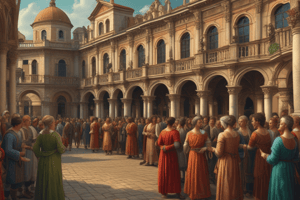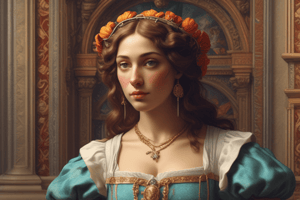Podcast
Questions and Answers
What was the primary inspiration for the Renaissance?
What was the primary inspiration for the Renaissance?
- A revival of interest in classical texts from ancient Greece and Rome (correct)
- The Age of Exploration
- Advancements in banking and bookkeeping
- The emergence of new commercial elites
What was the focus of humanism in education?
What was the focus of humanism in education?
- The development of new banking systems
- The exploration of new trade routes
- The study of classical history and literature (correct)
- The emergence of individualistic thinking
Who is known as the 'Father of Humanism'?
Who is known as the 'Father of Humanism'?
- Marco Polo
- Cicero
- Medici
- Francesco Petrarca (correct)
What was a result of increased trade and advancements in banking and bookkeeping?
What was a result of increased trade and advancements in banking and bookkeeping?
What was Francesco Petrarca's occupation?
What was Francesco Petrarca's occupation?
What did Francesco Petrarca search for during his journeys through Italy?
What did Francesco Petrarca search for during his journeys through Italy?
What was a characteristic of Renaissance art?
What was a characteristic of Renaissance art?
Which of the following best describes the focus of Northern Renaissance writers?
Which of the following best describes the focus of Northern Renaissance writers?
What was the main theme of Erasmus' book, The Praise of Folly?
What was the main theme of Erasmus' book, The Praise of Folly?
What was a key feature of the new monarchies in England, France, and Spain during the 15th century?
What was a key feature of the new monarchies in England, France, and Spain during the 15th century?
What was the result of the Spanish Reconquista in 1492?
What was the result of the Spanish Reconquista in 1492?
What was the title given to Ferdinand and Isabella of Spain?
What was the title given to Ferdinand and Isabella of Spain?
Flashcards are hidden until you start studying
Study Notes
The Italian Renaissance
- The Renaissance was inspired by a revival of interest in classical texts from ancient Greece and Rome and a shift towards a more secular and individualistic way of thinking.
- Humanism emphasized the study of classical history and literature as the foundation for education.
- Civic humanism prepared young people for careers in public service.
- Increased trade and advancements in banking and bookkeeping created wealth, and new commercial elites became patrons of the great Renaissance artists.
- Francesco Petrarca, known as Petrarch, was a fourteenth-century Italian poet who developed an interest in classical texts and recovered many of the writings of the ancient Roman philosopher Cicero.
- Petrarch is known as the “Father of Humanism” for his role in reviving scholarly interest in classical studies.
Renaissance Art
- Renaissance art focused on naturalistic portrayals of human subjects in imitation of the classical art of ancient Greece and Rome.
- Renaissance paintings emphasized balance, linear perspective, and bright colors.
- Scenes from classical literature were favorite subjects of Renaissance artists, showing the influence of humanistic studies.
- Raphael’s famous painting, The School of Athens, features the famous Greek philosophers, Plato and Aristotle, in the center of a congregation of philosophers from classical antiquity.
The Northern Renaissance
- The invention of the printing press spread interest in humanistic studies to Northern Europe.
- Northern Renaissance writers, such as Erasmus and Thomas More, produced printed works inspired by classical authors.
- Northern Renaissance writers were influenced by Christian humanism, producing works focused on Christian principles and social reform.
- Erasmus of Rotterdam, a Dutch humanist scholar, used the Gospels to criticize Catholic Church practices in his book, The Praise of Folly.
- Erasmus advocated for social reform by using classical texts to argue for the poverty of bishops.
New Monarchies
- During the Middle Ages, monarchs were not very powerful and often had to defer to the power of the Church and nobility.
- In the 15th century, monarchs in England, France, and Spain began to centralize power by collecting taxes directly and increasing control over the religious lives of their subjects.
- The new monarchs set the stage for absolute monarchies that ruled much of Europe two centuries later.
- The marriage of Ferdinand and Isabella united the Christian kingdoms of Aragon and Castile in Spain.
- They styled themselves as the “Catholic monarchs” and completed the Spanish Reconquista when they conquered Granada in 1492.
- The Catholic monarchs financed their campaigns through a “crusade tax,” which brought more money into the royal treasury.
Studying That Suits You
Use AI to generate personalized quizzes and flashcards to suit your learning preferences.




